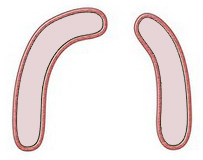A study is being highlighted by some in the cord blood–banking industry about a technique in development that uses cord tissue to repair a specific type of cleft lip and palate caused by bone material that has not properly fused together. As this study is currently being conducted in animals, it is hard to know if it will translate to humans; however, if it does move forward and get approved for clinical trials, it could provide a new, better option in alveolar repair.
Cleft Lip and Palate
Cleft lip and cleft palate are two of the most common birth defects, occurring together in one in 940 births. They develop in the womb between the sixth and tenth weeks of pregnancy, when skin tissue from either side of the head grows together to form the face. If these tissues fail to properly come together, the result can be a cleft lip, a cleft palate or both.
 Clefts can form if bones of the gum line fail to fuse together
Clefts can form if bones of the gum line fail to fuse together
Alveolar Cleft
While the cause of cleft lip and cleft palate are not completely known, it can occur when the bone of the gum ridge or front portion of the roof of the mouth fails to form properly and prevents the skin tissue from coming together. This is known as an alveolar cleft.
Aveolar Cleft Repair
While the lip and palate can be repaired soon after birth, fixing the bone material behind an alveolar cleft often has to wait until after the child’s baby teeth have fallen out but before the adult teeth have started to grow in, or until the child is approx. 7–9 years old. Bone grafts are the most common technique. It uses a small piece of bone from the hip, head, ribs or leg and places it in the area of the cleft. This obviously requires the child to undergo a surgical procedure prior to repairing the cleft to acquire the piece of bone. A newer technique uses stem cells from the bone marrow and a scaffolding material to form the base of the affected area. This technique also still requires a surgical procedure using anesthesia to acquire the bone marrow material.
Cord Tissue Cleft Repair
The University of Texas is developing a technique that uses the cord tissue to form the gum line and frontal areas of the roof of the mouth. As cord tissue is a gelatinous tissue (opposed to the liquid bone marrow), it will be possible to construct the bone area without scaffolding, and as clefts are formed early in pregnancy and can be diagnosed during ultrasounds, it is possible for families to collect and store their babies cord tissue easily at the time of birth in preparation for the procedure. This means the child will not have to undergo a surgical procedure to acquire the necessary repair materials. Researchers are also hopeful that cord tissue will enhance bone growth and accelerate healing over the other methods.
For the cord tissue procedure to be effective, it must be processed properly. There are a couple of different processing methods for cord tissue banking. One uses enzymatic digestion before the cryo-preservation process to isolate the stem cells. The other preserves the cord tissue mostly as-is and leaves any sort of processing until after the cord tissue has been retrieved and is being prepared for transplantation. The latter is the preferred method for this procedure. (Cryo-Cell uses a method where enzymatic digestion can take place after the cord tissue has gone through the freezing and thawing procedure similar to the one used in this study.)
University of Texas says multiple pre-clinical studies have demonstrated that cord tissue improves healing of cleft palate defects in animals and is now being used in larger animals as required by the FDA prior to translating this approach to treat children with cleft lip and palate. Once these final components are completed, they anticipate clinical trials should begin within the next 12–18 months.